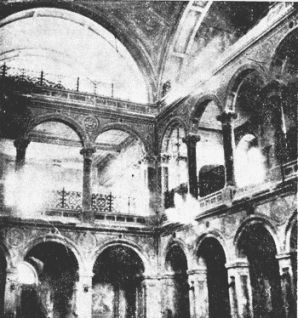
|
[Page 32]
| When life is getting harder,
Slumber will be heavy, For my compensation Heavens I must levy.
The sound of bygone prayers
Now the temple's empty,
By Sándor Lőwenstein, Tel-Aviv |
The small community, founded in 1749, had a prayer-house in one of the side streets of Bástya Utca (utca = street). As a temple they used a certain part of the complex that was later known as the Ungár mansion. The spacious complex had an apartment for the rabbi, and another one for the shochet or the melamed. The community was steadily growing, and the believers thought it was time to build a new temple, leaving the modest prayer-house in Salétrom Utca. A huge plot was purchased in Iskola Utca (today Petőfi Utca). The Protestant Church District had its High School and theological seminary located in the same street.
Count Pál Eszterházy, the patron of Pápa, contributed 100,000 bricks to the project of building a new temple. The temple was built in the neoclassical style, with some Florentine influence. The so-called synagogue chamber was simple, without any ornaments or steeple-like structures. It had entrances on three sides, with the main entrance opening from the temple courtyard. The door in the middle led to the men's section. Above the entrance there was a Biblical quotation:
“They shall make a Sanctuary for me so that I may live among them.” (Exodus 25:8)
Doors on the the left and on the right lead to the ezrat nashim, the women's section. Going up the marble staircase, you can get to the women's gallery on the first and second floors. If you enter from Petőfi Utca steps lead to the left-wing of the men's section, with gilded letters above the monumental door-leaf proclaiming:
“This is the gate of Heaven, the righteous shall enter it.”

In addition, there was a third door on the left, but it was kept closed most of the time: the marble stairs leading there served as a cosy place for children's games. (We could not wish for a better place to play our holiday games with walnuts and carob seeds.)
The large synagogue had two galleries and main hall could seat 800 men. It was constructed according to the plans of progressive-minded officials, with the bimah in front of the ark and a recess for an organ to be set up later on the second floor. (That point was never reached.) The bimah in front of the ark became a bone of contention: it was the only orthodox temple in the country with the bimah not in the center, as prescribed by the Shulchan Aruch. There were rabbis who refused to occupy the position of the chief rabbi at Pápa for this reason. R. Shimon Sofer, an outstanding member of the Pozsony rabbinical dynasty, who became later the chief rabbi of Kraków, wrote a letter to the community of Pápa in 1856, saying: “I cannot accept the offered rabbinical seat because of your failure to fulfil my request to place the bimah in the center.”
Above the ark, glittering letters proclaim:
“Be aware in front of whom you stand. I always keep God in sight.”
There were 40-45 Torah scrolls in the ark. To the left and to the right there were niches for the rabbis and the dayanim. There were three-four seats on both sides of the ark. The silver bowl and jug for the kohanim to wash their hands before blessing the congregation were set on a separate table. The pulpit was placed in front of the ark, and it was covered with white silk for the mazkir, instead of the usual wine-red silk. Only the elected rabbi was entitled to speak from here; visiting rabbis could preach only from the gallery next to the ark.
The temple was made up of three sections. From the main entrance we got into the vestibule with the memorial tablet of local Jewish heroes from the First World War. Memorial candles were lit here on their yahrzeit.
A Schuldiner was in charge of silence in the synagogue, his official hat bearing the inscription Pápai aut. Orth. Izr. Hitközség, the Autonomous Orthodox Israelite Community of Pápa.
Later on a group of the faithful started a campaign, to change the originally “neolog” arrangement, despite the fact that for seven decades the most pious believers had been happy to pray here, together with their rabbis and dayanim. Out of the old guard, only Spitzer Reb. Leml, the later Szepesváralja rabbi – at the time serving at Pápa – was notedly avoiding this temple. Finally, in 1919, they resolved the dispute by placing a bench in front of the ark and adding a curtain to the bars of the women's gallery; in this way lending the temple an orthodox character.
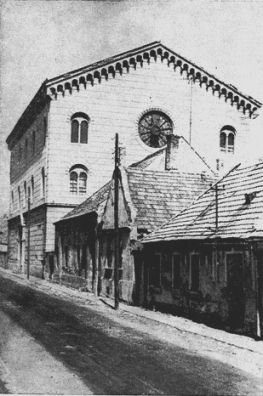 |
The temple's attic became the home of bats and owls. Our renowned temple was reduced to a storehouse for textile factories in Pápa
With painful tears, we cry out with the beginning words of Psalm 79:
“O God! The nations have entered into Your inheritance, they have defiled the Sanctuary of Your holiness.”
Words of lamentation pour forth from us:
“For these things do I weep; my eyes flow with tears.” (Lamentations 1:16)
Like a rainbow, the unforgettable memory of our beloved sanctuary shines through a cloud of tears.
[Page 35]
There is a story about Yochanan ben Zakkai, whose memory is cherished by ancient tradition. In 70 A. D. he did not beg the Roman general besieging Jerusalem to spare the sacred city, he only asked to be granted the town of Yavne so that he could teach there. Ever since then, Jews living in the Diaspora have considered it their duty of prime importance to set up schools and to teach their children.
There is no record of any public schools that could be found for the first years of the Pápa community. Several decades had to pass for the number of believers to become large enough and their cultural needs to develop. Up to that point, schools were cheders, set up by the private initiative and sacrifices of the families concerned. R. Wolf Rapaport, the chief rabbi elected in 1781, already founded a yeshiva, which turned out many famous rabbis.
The first Jewish public school under community supervision was started in 1826. (In Szeged the first Jewish public school was opened on December 22, 1844. The history of the Szentes community boasts of the fact that their school was already functioning in 1841.)
In 1839 members of the community urgently petitioned their officials, stressing the inefficiency of employing only teachers paid by the hour to teach the Hungarian language at the school run by the community. As a result, the officials decided to employ a qualified teacher for teaching the Hungarian language: this is how Mór Ballagi got to Pápa. Ballagi, who became later a member of the Hungarian Academy of Sciences, the editor of the Comprehensive Dictionary of the Hungarian Language, and whose Hungarian-German and German-Hungarian dictionaries appeared in numerous editions, was at the time still called Móric Bloch and as a youngster, had attended the Pápa yeshiva. He continued his studies at the University of Paris. His pamphlet: About the Jews, which he wrote there, attracted the attention of the minister Baron József Eötvös, who asked him to come back home, urging him to continue encouraging Jews to get fully Magyarized alongside fostering and developing a religious literature in Hungarian. For this reason, he was assigned the task of Magyarizing the Jewish school in Pápa. His Hungarian prayer book entitled The Supplications of Israel for the Whole Year (Izrael könyörgései egész évre) and his Hungarian translation of the Book of Joshua, together with the commentraries, were both written here.
In addition to Ballagi, the nationally famous teacher Béla Vályi was also entrusted with teaching the Hungarian language. In 1840, the community was planning to enlarge the school and Lipót Lőw (the rabbi of Nagykanizsa at the time) was commissioned to set up the school's rules and curriculum. However, the planned project was never realized. In 1846, when Lipót Lőw was chosen to be the chief rabbi of Pápa, he also became the school principal and was striving to invite the best teachers to Pápa. This teaching staff had excellent members: Ignác Baner, Manó Singer. According to contemporary records, he also joined the National Guard. Dr. Samu Zsengeri, the outstanding author on education, who was later commemorated by the memorial tablet on the school wall, was the son of this freedom fighter teacher.
A third teacher, Lipót Ehrenfeld, was also a brave fighter for the idea of Hungarian liberty: he was dispatched to the river Drava to help crush the rebellious minority nationalities.
The innovative ideas of Lipót Lőw failed to succeed, so most parents chose not to enroll their children at the public school, opting for a private school instead, until government commissioner, Antal Hunkár, closed down the private schools. After the defeat of the Hungarian War of Independence, the Bach-era set new directions for the school as well. The Governor's Council in Sopron ordered the school to be reorganized. Specialization was introduced. Teachers were usually employed for only one semester. The language of instruction could have been German, with the syllabus basically supplied by the Austrian curriculum. School fees depended on the parents' financial situation and ranged from 12 kreuzers to 2 forints, determined by the community officials.
A new period in the life of the school began with the 1859/60 school year. From this point on, the practice of employing teachers for only one term stopped. Instead, teachers were employed for three years and after a period of probation, they received tenure.
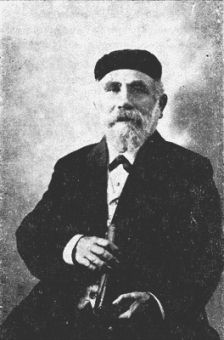 |
| Dayan and religious education teacher Hermann Eckstein |
From 1875 to 1880, there were two Jewish public schools in Pápa belonging to the two Jewish communities. When the two communities united, the orthodox school took over the teachers from the other school. This is how Ármin Schor, Mór Öszterreicher, and Franciska Reiner née Rosenthal got to the schools of the főhitközség, the head community, as it was called then.
Apart from the elementary school, the need for a secondary school had long been felt by the Pápa community. This was shown by the first attempt in 1878, at the initiative of chief rabbi Dr. Breuer, to create a Jewish reáliskola, a secondary school for modern languages and sciences. In the school year 1878/79 they opened first grade, which had 47 pupils, of which one was Roman Catholic. Antal Csemegi, Kálmán Vikár, and Ármin Schor were the teachers. The community could not support the costs of the secondary school so after a year of the experiment the school closed down.
On August 15, 1899, the school board discussed the initiative by Lipót Buxbaum, who “came up with the idea of founding a denominational higher elementary school in the local Jewish community” (polgári iskola). Chairman of the school board, József Steiner, made a fine speech supporting the realization of the idea. On August 20, 1899, the board of Pápa Autonomous
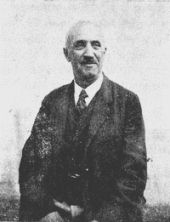 |
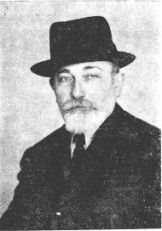 |
|
| Henrick Blau, school principal | Lipót Buxbaum, primary school principal |
Orthodox Israelite Community representatives accepted the proposal to set up a denominational higher elementary school for boys, which would accept pupils of other denominations as well, in accordance with the laws of the country. The first teaching staff was: principal Ármin Schor, Henrick Blau, Lipót Buxbaum, József Nussbaum, Mór Pfeiffer, Adolf Shisha (for secular subjects), art teacher David Hercz, dayan and religious education teacher Hermann Eckstein, and parish priest Jenő Kriszt, who taught religious education to Roman Catholic pupils. In the first school year, the school had 39 pupils in one class. At this time, that is, in the 1899/1900 school year, there were 169 girls and 206 boys at the elementary school, in separate classes, headed by the following teachers: in the boys' school, Adolf Schischa, first grade, Mór Pfeiffer, second grade, József Nussbaum, third grade, Lipót Buxbaum, fourth grade, while in the girls's school, Mór Öszterreicher, first grade, Róza Seelenfreund née Marton, second grade, Ármin Schor, third grade, and Franciska Rosenthal née Reiner, fourth grade. The children called their male teachers Tanító úr, meaning Sir, while addressing women teachers as Ténsasszony, meaning Madame.
For the purpose of the higher elementary classes, another floor was added to the elementary school building. The school acquired such a good reputation that 40 % of the pupils came from other denominations and in 1913, it had 134 pupils. After the death of Ármin Schor in 1912, Henrick Blau became the principal of the higher elementary school and filled the post until the school closed down. In the school year 1923/24 they had 163 pupils.
The places of teachers paid by the hour were filled by new teachers, who worked as regular teachers from the year in brackets marked after each name: Adolf Faragó (1914), Károly Láng (1918), Lajos Pollák (1921), Izsó Várhelyi (1911), and Andor Bihari (1924). High School teacher Elek Molnár worked here from 1907 until his conscription. In 1926 a one-year special commercial class for boys was added.
Every morning the pupils of the Jewish higher elementary attended the services held in the school's assembly hall turned into a temple, where the parochet in front of the ark had a Hungarian text embroidered in Hebrew letters proclaiming that it was a present from the Jewish pupils of the secondary school.
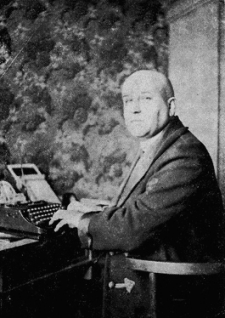 |
| Károly Láng, school teacher |
Religious education was taught intensively in the higher elementary school as well. They had the following subjects: Bible, with German translation, Psalms, with the classical German translation of Samson Rafael Hirsch, Kitzur Shulchan Aruch, Hebrew Grammar, Biblical story in Hungarian, Talmud: Masechet Beitzah and Bava Metzia. Pupils of the higher elementary school met on Shabbat afternoons in the autumn and winter months, led by their teacher Károly Láng, to read poems on Jewish subjects.
After 30 years, the renowned higher elementary school started to decline. In the school year 1928/29, they had only 103 pupils left. Some of the parents sent their children to – High School, others to yeshiva. As a result, the number of local Jewish pupils barely reached 30 %, so the community deemed the great sacrifice of maintaining the school pointless and decided to close it down. The death knell tolled; around this time teacher Károly Láng wrote to his brother living in the provinces, paraphrasing with resignation the well-known line from Heine: “Keine Messe wird man halten, keinen Kadisch wird man sagen”(Gedächtnisfeier by Heine). No mass will be held, and no Kaddish will be said. It was finished. Some of the teaching staff went to the town's vocational school; others went over to the Catholic Higher Elementary School.
However, the elementary school continued until the Shoah swept away the last members of teaching staff, together with their pupils.
The teachers's words teaching love and goodness were silenced; the madness of fascism murdered the children as well. The school building was left abandoned; the prayer after daily studies cannot be heard anymore:
We gratefully thank you, our good God –
Homewards bound when our feet trod –
Because we did our job so well –
Our heart and soul tending as well
The things we learnt well, grant us,
God, that at home will be noticed on us,
So our good parents will be happy and gay,
And for the glory of your Sacred Name
Amen.
Rabbis considered it their sacred duty to educate young people, preparing them in the yeshivas for a strictly religious way of living, teaching them to be pious and well-versed also in the devotional studies. R. Wolf Rapaport, elected in 1781, organized a large yeshiva in Pápa, which turned out outstanding rabbis. Even Lipót Lőw, the great reform-age rabbi had a yeshiva during his short time in Pápa. The father of Henrik Marcali, the great master of Hungarian historiography, was one of his students, and later became the rabbi of Marcali. Mór Ballagi, at the time Móric Bloch, also attended the Pápa yeshiva, later becoming a member of the Hungarian Academy of Sciences.
This blessed teaching job of religious education was continued by subsequent leading rabbis Salamon Breuer and M. A. Róth. When the latter made a stand supporting Zionism, the Ortodox rabbis of the periodfrightened his students away from him, so during his lifetime the yeshiva of Pápa stopped functioning. There was a long interval when the rabbinical seat remained unoccupied and for decades there was no yeshiva in Pápa. Yeshiva life in Pápa was restarted only after the First World War. The yeshiva was reorganized by Ezriel Gestettner, the son-in law of Vilmos Steiner, a respectable community chairman at the time. He was helped by Reb. Avraham Dirnfeld. Both led the yeshiva with great zeal. When the former Tolcsva rabbi Samuel Gottlieb z”l became the chief rabbi of Pápa in 1927, organizing a yeshiva was one of the first things he did. Unfortunately, this Ashkenazi yeshiva ceased to exist after a period of barely two years, when Rabbi Gottlieb died.
When Yechezkel Grünwald z”l, the former Bánfihunyad rabbi moved to Pápa in 1929, he immediately organized a chassidic yeshiva. In a short time, his yeshiva became so famous that the number of students grew to about 300. Strictly chassidic behaviour was required by the superiors, in addition to serious and profound learning. Many of the students continued their studies in Belz, and when they returned to their hometown, they wore chassidic attire. The long coats and beaver hats of the Pápa youngsters attracted great attention in the strictly Ashkenazi community. It is worth recording that when yeshiva students were drafted for forced labour service, Mihály Singer, a clothes dealer in Fő Utca (Main Street) provided for the needs of the destitute free of charge, despite the fact that he himself did not belong to the rabbi's followers. The Holocaust destroyed the Pápa yeshiva as well. Only a handful of the pious students survived, most of who live in Brooklyn with their offspring, devotedly attending the so-called 'Papa yeshiva'.
|
JewishGen, Inc. makes no representations regarding the accuracy of
the translation. The reader may wish to refer to the original material
for verification.
JewishGen is not responsible for inaccuracies or omissions in the original work and cannot rewrite or edit the text to correct inaccuracies and/or omissions.
Our mission is to produce a translation of the original work and we cannot verify the accuracy of statements or alter facts cited.
 Pápa, Hungary
Pápa, Hungary
 Yizkor Book Project
Yizkor Book Project
 JewishGen Home Page
JewishGen Home Page
Copyright © 1999-2024 by JewishGen, Inc.
Updated 4 Sep 2009 by LA